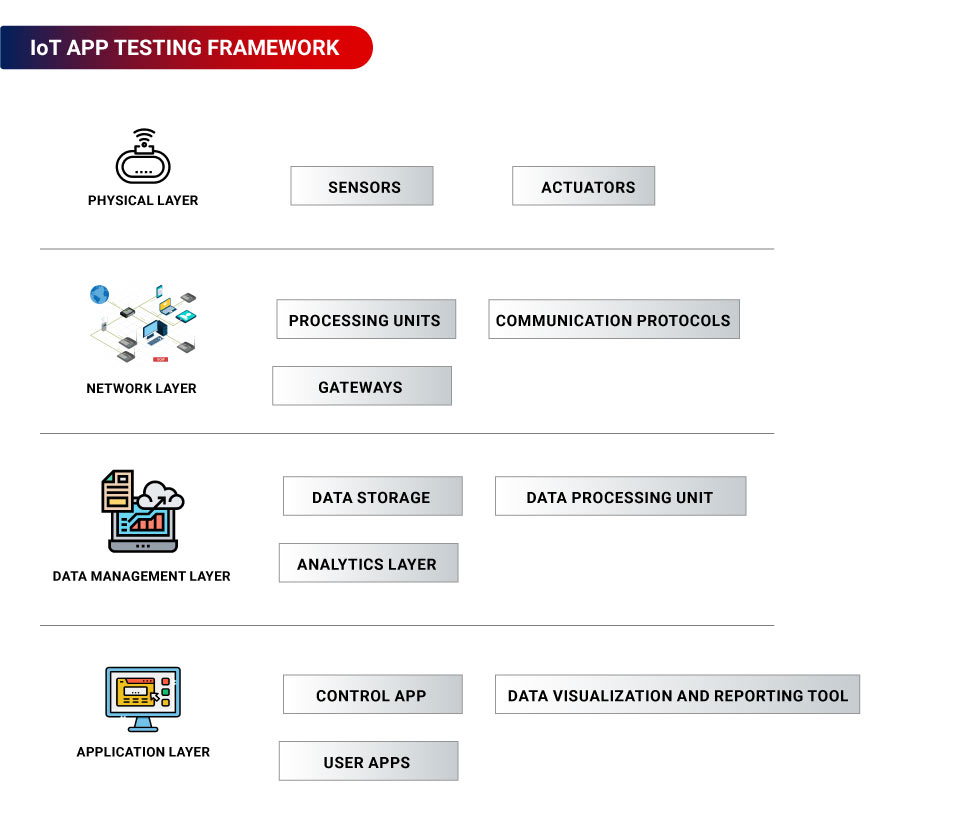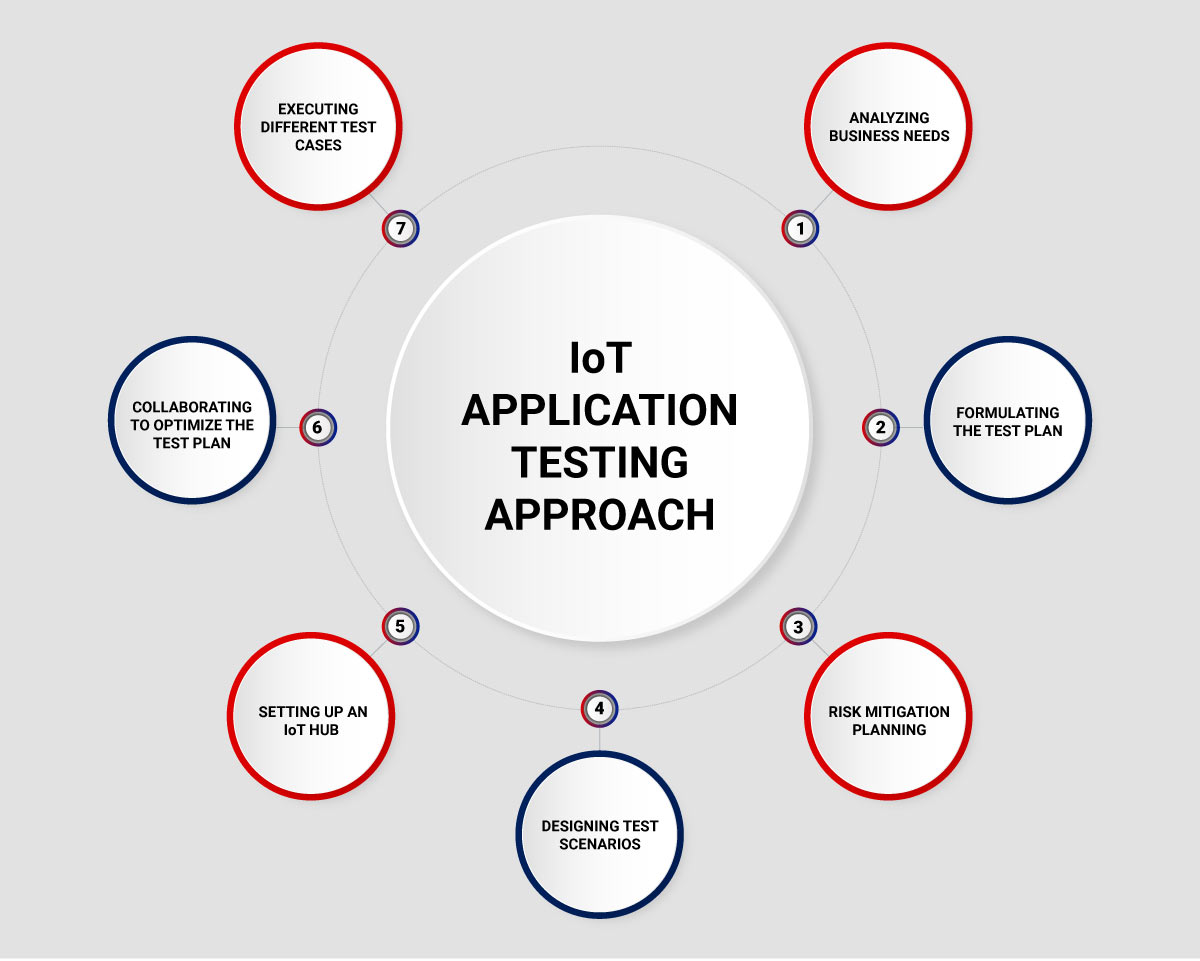There are more than 14 Billion IoT devices[1] connected to the internet in the world today. And this is just the beginning because digital transformation across businesses has just started to become something that is necessary.
The Internet of Things (IoT) has turned what once seemed like science fiction concepts into a reality, such as delivery robots, self-driven cars, smart home devices, surgical robots, and more. As sensors and networks, considered the foundation blocks of IoT, become more sophisticated and powerful and ease of network becomes easier, more than 41 billion IoT-connected devices will likely be in use by 2025, generating over 79 ZB of data[2].
If the IoT app you plan to introduce to the market is not thoroughly tested, it may lead to a bad user experience. Your product encountering critical bugs can also damage your organization’s reputation. Like other applications, IoT solutions also require multiple rounds of rigorous testing and thorough validation.
Let us walk you through the comprehensive guide to IoT application testing, and we will also explore the benefits, challenges, and framework underpinning the IoT testing process. So, let’s get started!
What is IoT Testing?
Internet of Things testing is a dynamic process involving various tests, methods, and tools tailored to ensure your IoT solution is ready to hit the market. It includes testing app functionality, performance, user experience, security, and network connectivity to identify and address any existing or potential vulnerabilities before deployment.
Since IoT is a heterogeneous network of underlying communication technologies and connected devices, IoT software testing adds a multidisciplinary approach to conventional software testing. It covers everything from testing scenarios and tailored strategies to virtualization and automation to validate the reliability, efficiency, and ability to transmit sensitive data across multiple devices and platforms. IoT as an industry is also emerging, so the forefront of technological development provides its challenges, making IoT application testing critical. To sum it up, Internet of Things testing helps you reduce the effort and cost of project modifications while accelerating your time to market.
IoT Testing Types
Types of IoT applications revolve around devices, security, analytics, networks, processors, platforms, and operating systems. To ensure the reliability and functionality of IoT systems, different types of testing are performed on IoT devices. Let’s explore the common types of IoT software testing:
Functional Testing
It is performed to validate the behavior and output of each component against the requirements, both in isolation and in the end-to-end workflows of the entire application.
Compatibility Testing
It focuses on ensuring that devices work seamlessly across different operating systems, browsers, and device configurations. This testing type verifies that devices can interact and operate seamlessly across a wide range of platforms for a consistent user experience.
Performance Testing
This is the second phase of IoT application testing that measures performance metrics such as latency, throughput, response time, and CPU utilization under stress loads and changing network conditions. It also considers the impact of thousands of devices continuously sending and receiving data.
Integration Testing
It is conducted to ensure seamless integration of your IoT application with enterprise systems, such as asset tracking, field service applications, ERP, CRM, and data warehouses. Integration testing also focuses on the seamless data transfer between your IoT app and third-party integrations while validating the compatibility of various critical components with the underlying tech stack.
Connectivity Testing
After the compatibility and performance testing validation, connectivity testing occurs as the 3rd phase. It is performed to ensure seamless data transmission between connected devices and the IoT network. It helps validate the stability and reliability of the connection, along with the ability of devices to establish and maintain uninterrupted connections. This IoT testing approach also confirms the device’s capability to handle different network conditions ranging from low bandwidth to intermittent connectivity.
Usability Testing
The testing focuses on assessing how easily end-users can interact with connected devices. It evaluates a device’s interface design, navigation, and overall user experience. Usability testing also helps identify potential issues and make improvements to enhance the device’s overall usability.
Security Testing
It focuses on the security of IoT field gateways and system architecture to ensure the resilience of your IoT solution against unauthorized access, data breaches, and malicious activities. Vulnerability assessment is equally crucial for identifying potential vulnerabilities in the software, firmware, or network infrastructure to enhance the security robustness of IoT apps.
IoT Testing Framework
When testing IoT applications, having a well-defined framework is crucial. An effective IoT Testing Framework comprises four essential layers ensuring comprehensive testing coverage.

Physical Layer
The physical components, such as sensors, controllers, and other connected devices, are at the core of any IoT ecosystem. The testing of this layer essentially focuses on validating the optimal functionality and reliability of these devices. It involves conducting tests to ensure accurate data collection, device communication, and strict adherence to predefined standards.
Network Layer
The network layer bridges the gap between the connected devices and gateways. The testing of this layer ensures seamless connectivity and swift data transmission across the IoT ecosystem.
Data Management Layer
This layer is responsible for storing, consolidating, and analyzing the data generated by IoT-powered devices. Testing this layer helps validate secure data storage, aggregation, processing, and retrieval.
Application Layer
This layer includes the front-end components responsible for reporting, control, and data visualization. Testing at this layer focuses on validating the user interface’s functionality, performance, and responsiveness, ultimately impacting data presentation for effective decision-making.
Common Challenges of IoT Testing and How We Address Them at Rishabh Software
IoT application testing ensures optimal functioning and robust security of connected devices. However, just like any software testing process, IoT app testing is not without challenges. Listed below are the top eight IoT testing challenges that most QA teams face:
Strengthening Data Security
Even a small malfunction can expose IoT devices to several major risks and trigger devastating outcomes such as security lapses or non-optimal use of resources. At Rishabh Software, we employ rigorous security measures to maintain the integrity of the data generated by IoT devices. It includes robust encryption protocols such as TLS and SSL, stringent user access controls, and anti-theft mechanisms to prevent unauthorized access and data breaches.
Device Diversity Management
Testing many IoT devices with distinct features, capabilities, and constraints is one of the biggest IoT testing challenges. Our proficient team is well-versed in the intricacies of testing various device types and possesses the knowledge and experience to fulfill specific testing requirements, ensuring comprehensive coverage for every device type.
Standardization of Solutions
The ever-evolving nature of the IoT industry poses a challenge regarding standardization. Our experienced QA team overcomes this obstacle by employing a dynamic testing strategy that adapts to each IoT solution’s peculiar features. For effective testing, we tailor blueprints of test cases using the most appropriate mix of integrations.
Anticipating User Behavior
Users interact with IoT products in various ways, from minimal interaction to daily engagement. Our skilled team considers the broad spectrum of user behaviors, paying detailed attention to all possible interaction scenarios. This meticulous approach ensures that our IoT testing solutions meet end-user needs and expectations efficiently.
Tackling Complex Variables
IoT products are a combination of hardware, software, and cloud technologies. Our comprehensive testing process caters to this complexity by thoroughly assessing each variable to identify potential vulnerabilities and ensure optimal performance.
Hardware Optimization
We recognize the importance of maintaining and optimizing IoT device hardware. Therefore, our QA engineers employ proactive measures to address the need for periodic maintenance and regular battery charging. We go light on updates and testing as it helps ensure that the devices remain secure, updated, and fully operational.
Various Cloud Platforms
The smooth running of IoT devices depends on seamless cloud connectivity. We ensure their usability and performance by thoroughly testing devices on a cloud platform. We also perform accuracy and integrity checks on the structured and unstructured data generated by the IoT ecosystem to achieve the expected outcomes.
Different Communication Protocols
IoT-enabled devices use real-time communication protocols like XMPP, AMQP, MQTT, and CoAP to establish connections between embedded sensors and the server. Plus, different components within an IoT system may use additional communication protocols for seamless interaction. By thoroughly testing these components over communication protocols, we prevent latent failures that can lead to functional or security issues. For instance, embedded sensors can often suffer from memory overload due to excessive requests and fail to operate correctly. We ensure the optimal load balance between different components through IoT app testing.
Benefits of IoT Testing
Rigorous testing of IoT applications helps your business enhance the app’s reliability and accelerate speed-to-market. Let’s now look at the key advantages of IoT app testing:
- Enhanced Reliability: Testing IoT applications ensures that they operate flawlessly and offer a seamless user experience while minimizing the risk of system failures.
- Improved Security: IoT application testing enables you to strengthen the security of connected systems against potential threats. It protects devices from unauthorized access and maintains data privacy.
- Optimal Performance: IoT applications typically operate in remote environments and handle massive data. Testing them helps identify bottlenecks, ensure efficient data transmission, and maximize resource utilization for optimized app performance. For instance, a smart city project employing a well-tested IoT-powered app can adjust traffic signals in real-time, reduce congestion and improve commute times for its citizens.
- Seamless Integration: IoT projects must integrate different connected devices and systems seamlessly. Thorough IoT testing ensures compatibility and seamless interoperability across different IoT platforms. It’s like a smartwatch communicating with your phone, car, and home appliances to simplify your life.
- Scalability: Successful IoT solutions are designed to accommodate ever-growing data demands and emerging technologies. Stress-testing your IoT app’s scalability ensures it can efficiently handle sudden spikes in data volume, device connectivity, and user interactions.
- Cost Savings: IoT application testing helps you identify and rectify issues early in the development cycle, thus averting costly failures. Plus, comprehensive testing methodologies help streamline the development processes and reduce time-to-market.
7-Step IoT Testing Process
Our IoT app development services ensure the quality and reliability of your IoT apps. The following are the key steps we follow to deliver high-quality IoT solutions.

Step #1 Gaining Clarity on Configured Devices and Business Needs
Understanding the configured devices’ expected functions helps align them with the business needs. This clarity guides the next steps of our testing strategy.
Step #2 Create A Best-fit IoT Test Plan
The QA manager designs an IoT test strategy and plan, which includes comprehensive testing coverage and ways to address potential vulnerabilities. It serves as a blueprint to define the testing objectives, appropriate methodologies, and the scope and timeline to execute testing activities.
Step #3 Identifying IoT Testing Risks and Mitigation Plan
Next, we identify potential risks specific to IoT applications in your industry. We then assess the security vulnerabilities, potential connectivity issues, compatibility challenges, and performance bottlenecks. Our team develops a robust mitigation plan based on the risk assessment to address these risks proactively.
Step #4 Designing Test Scenarios Based on Requirements
Our skilled team then designs and tests scenarios that validate your IoT applications’ functionality, performance, and reliability. These scenarios are customized to deliver on specific requirements of the application and the industry use case. The team tries to cover various test cases to simulate various use cases and scenarios.
Step #5 Setting up the Right Environment and IoT Hub
We then set up an IoT hub replicating real-world connectivity scenarios to create powerful IoT simulations and execute tests in a controlled environment. This allows us to evaluate the functionality and reliability of the IoT application.
Step #6 Collaborative Approach Combines Technical and Design Teams
Our collaborative approach ensures a cross-functional team of IoT testers, developers, and designers. We let you leverage our team’s combined technical competencies and experiences to identify potential issues and deliver high-quality software.
Step #7 Planning Each Test Phase based on Test Approach Categories
We carefully plan each test phase based on the categories defined in our test approach to arrive at a structured and organized testing process. These include regression testing, integration testing, performance testing, security testing, connectivity testing, and compatibility testing, among others.
Our experienced IoT app development team specializes in comprehensive software testing and quality assurance services to ensure the flawless performance and functionality of your IoT products and solutions. Connect with our IoT testing experts to accelerate your business IoT initiatives.
Best IoT Testing Tools
Having the right testing tools at your disposal can greatly enhance your IoT app testing projects. At Rishabh Software, our QA experts employ the best IoT testing tools to deliver robust and reliable IoT apps.
- API Testing: We leverage tools like Postman, Swagger, and SOAP to test APIs’ functionality and performance in your IoT applications. These tools enable us to validate responses and verify the behavior of your API endpoints so you can be sure of seamless communication between your IoT devices and the API infrastructure.
- Performance Testing: To ensure that your IoT app can handle heavy usage and fluctuating demands, we use JMeter. Using this tool, we simulate high loads, assess response times, and analyze the scalability and reliability of an IoT solution.
- Network Protocol Analyzer: For tracking and troubleshooting network-related issues, we use WireShark. It enables us to identify network problems and optimize configurations for seamless communication between connected devices and the IoT network infrastructure.
How Can Rishabh Software Help You with IoT App Testing?
As your one-stop IoT app testing partner, we offer comprehensive IoT testing services to address the heterogeneity of devices, protocols, and technology platforms. We focus on your business-specific needs of IoT testing and objectives to promise seamless performance and functionality.
We possess hands-on experience with advanced testing tools and network protocols to move your IoT products to market faster.
At Rishabh, we provide end-to-end IoT testing services by a vetted team of IoT-skilled testers and robust IoT testing infrastructure. Leverage our expertise in IoT testing today for scalable, smart IoT products and solutions.
FAQs
Q: What are some best practices to follow for IoT application testing?
A: Some proven best practices for IoT application testing include:
- Thorough regression testing
- Integration testing across devices and platforms.
- Performance and security testing
- Ensuring seamless connectivity and data transmission
- Comprehensive compatibility and usability testing
Q: What are the major cost factors to consider in IoT application testing?
A: IoT app testing is complex and challenging. Here are a few major cost factors to consider in IoT application testing:
- Challenge and constraints of the IoT ecosystem to be tested.
- Number and types of connected devices.
- Number of team resources one will need.
- Required level of proficiency of the team resource.
- Need for a specialized testing infrastructure along with the tech stack.
- Expected duration of testing cycles
Q: What roles are essential in an IoT application testing team?
A: An IoT app testing team ideally consists of:
- IoT test engineers for testing the connectivity of IoT devices.
- Skilled test automation engineers for developing automated test scripts.
- Domain experts with in-depth knowledge of the IoT ecosystem and industry-specific compliance regulations.
Q: What is IoT automation testing?
A: IoT automation testing involves executing QA tests to check IoT devices’ functionality, security, and performance. It leverages automated tools and frameworks to streamline and speed up the IoT app testing process.
Q: What are the benefits of IoT automation testing?
A: IoT automation testing ensures the following key benefits:
- Faster execution of tests
- Increased test coverage
- Improved testing accuracy and consistency
- Reduced manual errors.
It allows you to conduct continuous testing in agile environments while ensuring better scalability for extensive IoT deployments.
Footnotes:
1. https://iot-analytics.com/number-connected-iot-devices/
2. https://www.iiot-world.com/industrial-iot/connected-industry/new-iot-signals-report-by-microsoft/










 30 Min
30 Min


